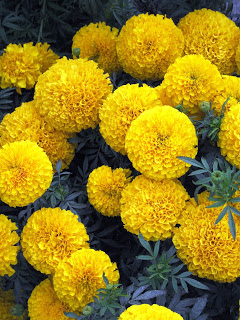By Mary Hinkley, an Alaska Master Gardener in Tok, Alaska
I believe in marigolds. Though marigold’s pest resistant qualities are mentioned on many of their seed packets, I feel they’re under rated. Most of my raised beds have a marigold border. This serves two purposes; the garden is beautiful and it’s safe from pest invasion. Early this season I went to the local nursery to get some for my greenhouse and found that it was too early for their marigold crop, so I bought some seeds, went home, and planted eight flats.
 |
| The vibrant orange of marigolds contrasts well with the blue lobelia. Photo by Heidi Rader. |
I love marigolds. I remember my mother always included them in her garden; she said it was for protection. In fact, in the Northeast, where I’m from, most everyone I knew planted them and it was a known fact that they kept pests
away. Snooks tells of the time he gathered a bushel of corn from his garden to give to his sister. His garden was
pest free and protected due to its marigold border. However, when he left the bushel of corn on the porch overnight, away from protection, the raccoons devoured every ear by morning. They didn’t touch the standing corn, twenty feet
away in the marigold-framed garden.
Here in Alaska, I’ve had two encounters with cutworms all year; I found a young bean plant taken off at its base and a severed young marigold. It seems that whatever worm did that, if he lived to tell about it, he never came back for more and warned all of his friends of the nasty encounter! I don’t think marigolds are poisonous–just very distasteful. The bean plant succumbed, I believe, because the marigolds were still quite young and hadn’t established themselves. Everything else in my garden is still standing.
I planted marigolds around cabbage to keep cabbage worms away. I’ve never read that they do, but thought I’d try it, and so far, so good.
 |
| ‘Giant Yellow’ marigolds. Photo by Heidi Rader. |
I learned something else about marigolds with the cabbage patch.
They don’t like the cold. When I planted my cabbage in mid-May I edged the
patch with marigolds and used row cover at night. The cabbage survived, but
even with the row cover, not one marigold made it through the first night. I
waited for another few weeks before I planted more.
The onion and garlic bed even has a marigold border. I wasn’t going to do it; I thought that they were pungent enough to keep any pest
at bay. Then I talked to a friend who told me of a season he lost an entire crop of onions due to some kind of underground attack, perhaps nematodes. He said they looked perfectly fine until he harvested them, but then there was nothing in the bulb. The next day I edged the garlic and onion bed. I’ve found that the roots of marigolds are as protective as their leaves and flowers, and
they work below the ground as well as they do above it.
Thanks to marigolds the rabbits leave my lettuce alone, peas and carrots as well. My asparagus patch is marigold free because there just wasn’t room for them. However, it’s surrounded by other marigold bordered raised beds and the asparagus has fared well to this point.
Marigolds come in many varieties and sizes and are even edible–particularly the ‘Golden Gem’ and ‘Tangerine Gem’ varieties. Their colors range from bright yellow to orange to maroon. They have lovely flowers with a kaleidoscope of color combinations and when I’m watering my garden they always make me smile–plus they attract beneficial insects.
 |
| ‘Lemon Gems’ make the perfect addition to any salad. |
Edible, beneficial and beautiful, marigolds are my greenhouse
guardians and keepers of my garden.
Share this.


